A History of Western Music 9th Edition Chapter Summary
Grout Music History Resources
1. Music History Quiz
This quiz is based on J. Peter Burkholder, Donald J. Grout, and Claude V. Palisca, A History of Western Music, Ninth Edition.
There are three formats: Multiple choice By chapter and By genre and a Fill-in-the-blank quiz. Make a selection by clicking on a radio button and then click the Start
button. Click on the answer that is correct.
Consider questions that have only one answer to be a fill-in-the-blank question, and try it both ways (i.e., look at the answer and think of the question).
Here is the PC version and the Mac version. And here are screen shots.
Or I'll send a .zip file tdubois@wtamu.edu
2. Worksheets
Ninth edition worksheetsNinth edition worksheet answers
Ninth edition worksheets with answers
Eighth edition worksheets
Seventh edition worksheets
Sixth edition worksheets
I've developed study guide questions beginning with the fifth edition as part of my course syllabus. They are set up in two column format, printed two sides. For the fall semester there are 30 sheets and a similar number for the spring. They're homework for the students, and I award 1 point per column to be added to the test grade for that unit. Generally, one set of questions is due at the beginning of class. Here is the explanation that's in my syllabus:
The purpose of the study guide questions (= worksheets) is to provide a review of what the student has read and to help the student focus on important details of the textbook. (Thus, the kinds of questions posed could serve as a model for other courses where the student is responsible for comprehension of the text.) Finding the answers to each question is not the sole objective of these study questions nor should students look for ways to shortcut the system. Most important is paying attention to the writing style, sentence structures, development of the paragraph, punctuation, etc.
Before looking at the questions, I would suggest that the student read a section of the chapter, such as "Aspects of Eighteenth-Century Life" in chapter 13 (6th edition). The student could then check for comprehension by mentally answering the questions. Finally, answers should be written in the space provided in order to facilitate review before a written test.
The abbreviation TQ is a thought question for which the text does not supply the answer. [The answers for these questions won't necessarily be the same for every student.] Students should answer these thought questions and also develop others that may occur to them as they read. An end-of-the-chapter example of a thought question for chapter 13 (6th edition) might be "What are the major points in this chapter?" or "If I were given the names of 18th-century operas, could I match them to their composer or to their English translation or to their type (comic or serious) or to their school?" or "Could I synthesize several questions in order to answer an essay question about a particular topic?"
Ninth Edition Worksheets
| Chapter 1 | Chapter 11 | Chapter 20 | Chapter 30 |
| Chapter 2 | Chapter 12 | Chapter 21 | Chapter 31 |
| Chapter 3 | Chapter 13 | Chapter 22 | Chapter 32 |
| Chapter 4 | Chapter 14 | Chapter 23 | Chapter 33 |
| Chapter 5 | Chapter 15 | Chapter 24 | Chapter 34 |
| Chapter 6 | Chapter 16 | Chapter 25 | Chapter 35 |
| Chapter 7 | Chapter 17 | Chapter 26 | Chapter 36 |
| Chapter 8 | Chapter 18 | Chapter 27 | Chapter 37 |
| Chapter 9 | Chapter 19 | Chapter 28 | Chapter 38 |
| Chapter 10 | | Chapter 29 | Chapter 39 |
Ninth Edition Worksheet Answers
| Chapter 1 | Chapter 11 | Chapter 20 | Chapter 30 |
| Chapter 2 | Chapter 12 | Chapter 21 | Chapter 31 |
| Chapter 3 | Chapter 13 | Chapter 22 | Chapter 32 |
| Chapter 4 | Chapter 14 | Chapter 23 | Chapter 33 |
| Chapter 5 | Chapter 15 | Chapter 24 | Chapter 34 |
| Chapter 6 | Chapter 16 | Chapter 25a 25b | Chapter 35 |
| Chapter 7 | Chapter 17 | Chapter 26 | Chapter 36 |
| Chapter 8 | Chapter 18 | Chapter 27 | Chapter 37 |
| Chapter 9 | Chapter 19 | Chapter 28 | Chapter 38 |
| Chapter 10 | | Chapter 38 | Chapter 39 |
Ninth Edition Worksheets with Answers
| Chapter 1 | Chapter 11 | Chapter 20 | Chapter 30 |
| Chapter 2 | Chapter 12 | Chapter 21 | Chapter 31 |
| Chapter 3 | Chapter 13 | Chapter 22 | Chapter 32 |
| Chapter 4 | Chapter 14 | Chapter 23 | Chapter 33 |
| Chapter 5 | Chapter 15 | Chapter 24 | Chapter 34 |
| Chapter 6 | Chapter 16 | Chapter 25 | Chapter 35 |
| Chapter 7 | Chapter 17 | Chapter 26 | Chapter 36 |
| Chapter 8 | Chapter 18 | Chapter 27 | Chapter 37 |
| Chapter 9 | Chapter 19 | Chapter 28 | Chapter 38 |
| Chapter 10 | | Chapter 29 | Chapter 39 |
Eighth Edition Worksheets
| Chapter 1 | Chapter 10 | Chapter 19 | Chapter 28 |
| Chapter 2 | Chapter 11 | Chapter 20 | Chapter 29 |
| Chapter 3 | Chapter 12 | Chapter 21 | Chapter 30 |
| Chapter 4 | Chapter 13 | Chapter 22 | Chapter 31 |
| Chapter 5 | Chapter 14 | Chapter 23 | Chapter 32 |
| Chapter 6 | Chapter 15 | Chapter 24 | Chapter 33 |
| Chapter 7 | Chapter 16 | Chapter 25 | Chapter 34 |
| Chapter 8 | Chapter 17 | Chapter 26 | Chapter 35 |
| Chapter 9 | Chapter 18 | Chapter 27 | Chapter 36 |
Seventh Edition Worksheets
| Chapter 1 | Chapter 10 | Chapter 19 | Chapter 28 |
| Chapter 2 | Chapter 11 | Chapter 20 | Chapter 29 |
| Chapter 3 | Chapter 12 | Chapter 21 | Chapter 30 |
| Chapter 4 | Chapter 13 | Chapter 22 | Chapter 31 |
| Chapter 5 | Chapter 14 | Chapter 23 | Chapter 32 |
| Chapter 6 | Chapter 15 | Chapter 24 | Chapter 33 |
| Chapter 7 | Chapter 16 | Chapter 25 | Chapter 34 |
| Chapter 8 | Chapter 17 | Chapter 26 | Chapter 35 |
| Chapter 9 | Chapter 18 | Chapter 27 | |
Sixth Edition Worksheets
| Chapter 1 | Chapter 9 | Chapter 17 |
| Chapter 2 | Chapter 10 | Chapter 18 |
| Chapter 3 | Chapter 11 | Chapter 19a |
| Chapter 4 | Chapter 12 | Chapter 19b |
| Chapter 5 | Chapter 13 | Chapter 20a |
| Chapter 6 | Chapter 14 | Chapter 20b |
| Chapter 7 | Chapter 15 | Chapter 21 |
| Chapter 8 | Chapter 16 | Chapter 22 |
3. DodecaFinder
DodecaFinder is a standalone application created using Revolution (by Runtime Revolution, Ltd.) to be used with 12-tone compositions. Once a series has been entered, the application will create the 12 X 12 grid and users can search for two- and three-string pitches and the program will highlight those boxes.
Here is the Macintosh version and the PC version.
Please send suggestions and/or comments to tdubois@wtamu.edu
Return to top of page
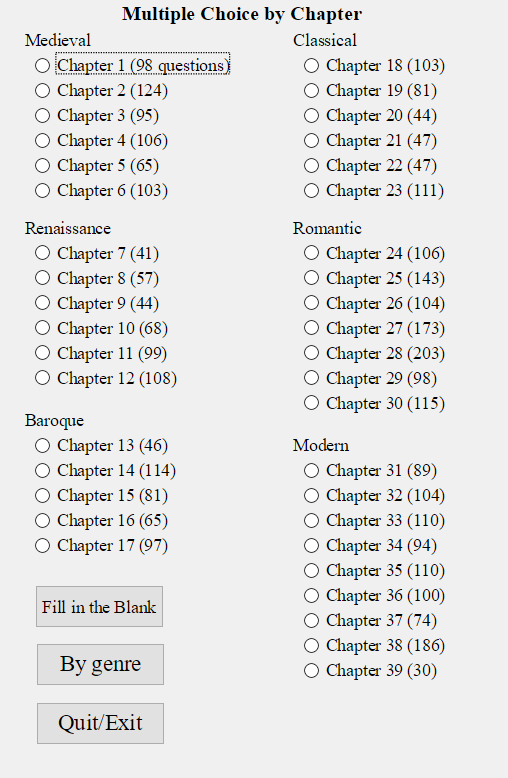 | This is the opening card. Questions are grouped by chapter. (At the bottom of the page are navigation buttons to a Fill in the Blank quiz or a multiple choice By Genre quiz.) Click a radio button to go to the game layout. Click the "QUIT" button to exit the program. |
| This is the layout for the game. The "Easy" button will give you three choices for each question; "Medium," four choices; "Hard," five choices. Click one of the buttons to start the game. Read the question then click the box has the correct answer. A green background indicates the correct answer; a red background is a wrong answer. Proceed by clicking "Next" to see a new question. When you run out of questions, click the "Quit" button to return to the By Chapter page. Clicking "Quit" on the By Chapter page will allow you to exit the program. | 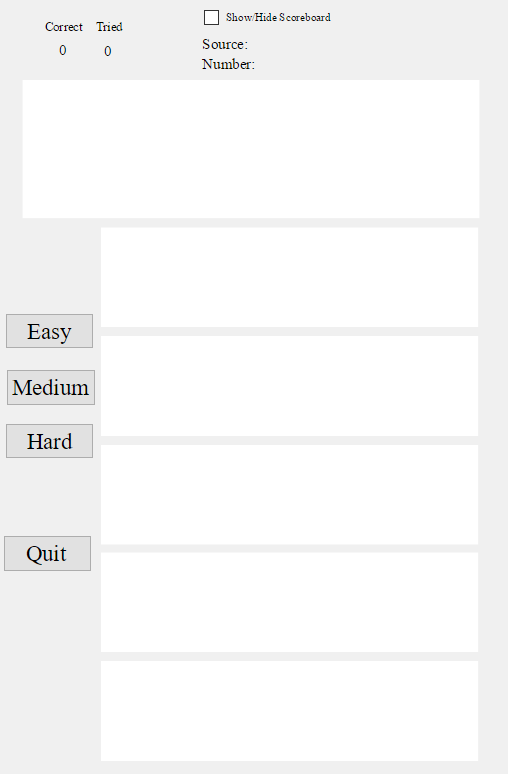 |
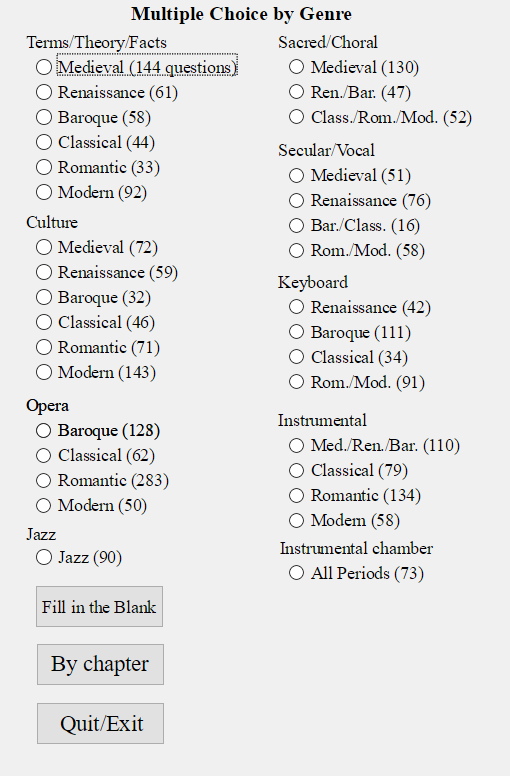 | This is the By Genre page. It's organized by period and works the same way as the By Chapter page. Click a radio button to get started. |
| Here is the Fill-in-the-Blank page. It's organized by chapter. Clicking a radio button will take you to the next page where you will play the game. Clicking the "Quit" button while on the Fill-in-the-Blank page will take you back to the By Chapter page. | 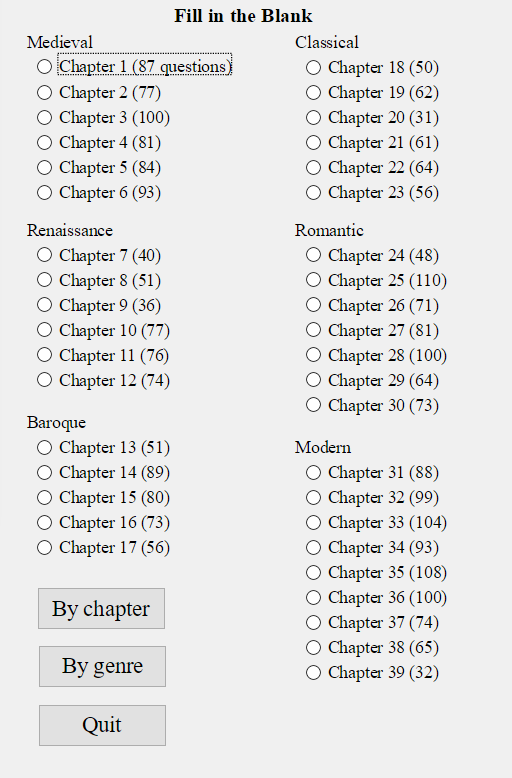 |
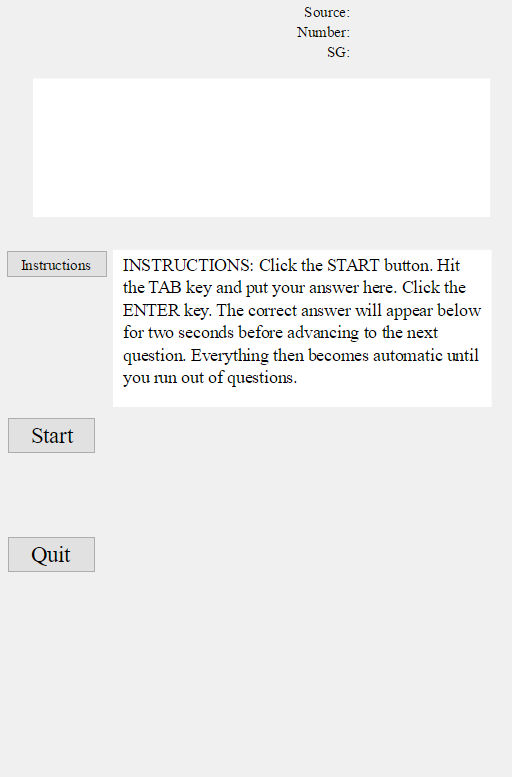 | This is the layout for Fill-in-the-Blank quiz. THE INSTRUCTIONS ARE IMPORTANT. Click the "QUIT" button to return to the Fill-in-the-Blank home page. |
A History of Western Music 9th Edition Chapter Summary
Source: https://www.wtamu.edu/~tdubois/GroutResources.htm